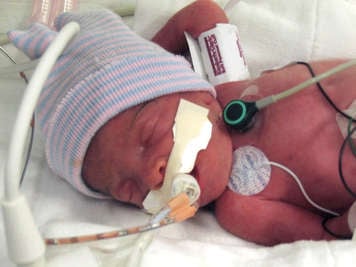Chronic lung disease (CLD) often occurs as a result of mechanical ventilation. CLD, which is sometimes called bronchopulmonary dysplasia (BPD), may also come as a result of respiratory distress syndrome (RDS) and early infection of the amniotic cavity.

Some babies with RDS need a ventilator to help them breathe; in many cases this is a life-saving intervention. However, both oxygen and mechanical ventilation can have a bad effect on a lung that is still developing or a lung that is damaged and in the process of repairing itself. Many mechanisms that protect the lung from injury are incompletely developed or not present. If the baby was still in the womb, the lungs would be filled with fluid that would protect them and allow them to develop. The longer a child needs mechanical ventilation, the more likely it is that they will develop CLD. About 50% of extremely premature babies who have RDS will have CLD to some degree. In many ways, CLD is a consequence of surviving RDS and other lung complications. Luckily, severe CLD is rare and most babies mature without major long-term breathing complications.
Babies with CLD need to be managed carefully. They are at risk for fluid build-up in the lungs, they tire out easily from the effort required to breathe, and they may have other conditions that make CLD more of a challenge.
Mechanical ventilation
Of all the interventions developed to help premature babies survive and eventually go on to develop normally, mechanical ventilation has probably had the single largest positive effect. Before ventilation technologies were developed, many premature babies did not survive or survived with severe developmental complications that would adversely affect their quality of life.
While ventilation is a life-saving technique, it can also cause problems. A premature baby’s lungs are often weak and may be inflamed, a common effect of RDS. The baby needs a ventilator to help them breathe; however, the fragile lungs can be damaged by the pressures and size of the ventilator breaths. As the lungs attempt to repair the damage, the force of the ventilator and the extra oxygen can interfere with the healing process and the new tissues may not form normally. Several newer ventilation technologies attempt to address these problems and may reduce the amount of ongoing damage to the developing lung. Non-invasive continuous positive airway pressure (CPAP) is a way of administering a small amount of pressure through soft nasal prongs to a baby who is at risk for developing lung collapse after the breathing tube has been removed. This device has helped many babies come off the ventilator much sooner. The health care team will always attempt to use the lowest effective pressure and size of breath from the ventilator to avoid any damage to lung tissues.
In addition to carefully finding the most appropriate ventilator settings, the health care team may occasionally give a baby with CLD drugs called diuretics to remove fluid from the lung, or bronchodilators to encourage the airways to stay open. The baby will gradually be weaned off the ventilator as they become more able to take on the work associated with breathing.
Although many babies fully recover from CLD, there are several long-term risks, including respiratory infections and asthma. Additionally, some babies with CLD to have a smaller lung capacity, which may restrict how active the child can be as they grow up.